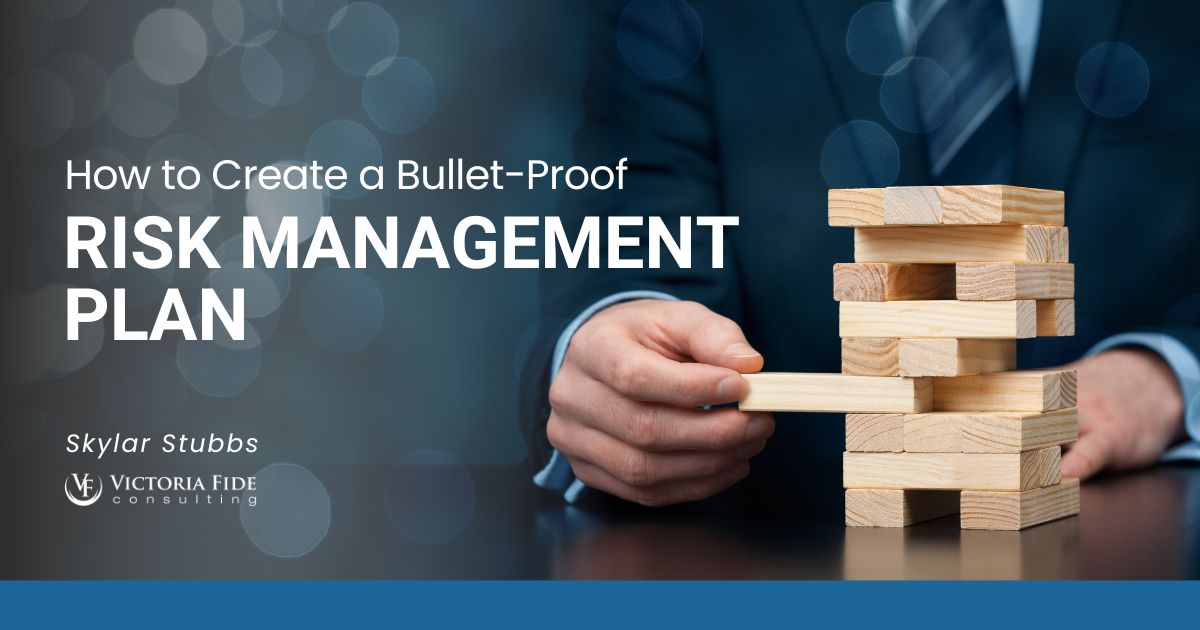
How to Create a Bullet-Proof Risk Management Plan
You identify them, record them, monitor them and plan for them: risks are an inherent part of every project. Some project risks are bound to come up—like minor resourcing constraints and at least a little scope creep. But there are many risks within any given project that, without risk assessment and risk mitigation strategies, can come as unwelcome surprises to you and your project management team.
That’s where a risk management plan comes in—to help mitigate risks before they become major problems. But first, what is project risk management?
Table of Contents
What Is Risk Management?
Risk management is an arm of project management that deals with managing potential project risks. Managing risks is arguably one of the most important aspects of project management.
The risk management process has the following primary steps:
- Risk Identification: The first step to managing project risks is to identify them. Use data sources such as information from past projects or subject matter experts’ opinions to estimate all the potential risks that can impact the project.
- Risk Assessment: Once the project risks are identified, prioritize them by looking at their likelihood and level of impact.
- Risk Mitigation: Now it’s time to create a contingency plan with risk mitigation actions to manage your project risks. You also need to define which team members will be risk owners, responsible for monitoring and controlling risks.
- Risk Monitoring: Risks must be monitored throughout the project lifecycle so that they can be controlled.
Even one risk can jeopardize the entire project plan, and there are many risk categories that require assessment and discussion with stakeholders. That’s why risk management needs to be both a proactive and reactive process that is constant throughout the project lifecycle.
Now, let’s define a risk management plan.
What Is a Risk Management Plan?
A risk management plan defines how the project’s risk management process will be executed. That includes the budget, tools and approaches that will be used to perform risk identification, assessment, mitigation and monitoring activities.
A risk management plan usually includes:
- Methodology: Define the tools and approaches that will be used to perform risk management activities such as risk assessment, risk analysis and risk mitigation strategies.
- Risk Register: A risk register is a chart to document the risk identification information.
- Risk Breakdown Structure: This is a chart that identifies risk categories and the hierarchical structure of project risks.
- Risk Assessment Matrix: A risk assessment matrix allows teams to analyze the likelihood and the impact of project risks so they can prioritize them.
- Risk Response Plan: A risk response plan is a project management document explaining the risk mitigation strategies used to manage risks.
- Roles and Responsibilities: The risk management team members have responsibilities as risk owners. They need to monitor project risks and supervise their risk response actions.
- Budget: Have a section to identify the funds required to perform risk management activities.
- Timing: Include a section to define the schedule for the risk management activities.

Transformation is not easy, but it doesn’t have to be impossible. Take control of your project’s success today and schedule a free 30-minute consultation to find out how Victoria Fide can equip you for transformational success.
How to Make a Risk Management Plan
For every digital transformation project, there will be risks. That’s the nature of these important yet complex project initiatives. But that’s also why it’s best to get ahead of them as much as possible by developing a proactive risk management plan. Here are 7 steps to creating a great risk management plan:
1. Risk Identification
Risk identification occurs at the beginning of the project planning phase, as well as throughout the project life cycle. While many risks are considered “known risks,” others might require additional research.
Create a risk breakdown structure to identify project risks and classify them into risk categories such as timeline, budget, and scope. This is done by interviewing all project stakeholders and subject matter experts. Additionally, create a risk register to share all known risks revealed during the identification phase in a centralized location available to all relevant parties.
2. Risk Assessment
Next, review the qualitative and quantitative impact of the risk and map that out into a risk assessment matrix. This is done by assigning the risk likelihood a score from low probability to high probability. Then, map out the risk impact from low to medium to high and assign each a score. This provides an idea of how likely the risk is to impact project success as well as how urgent the response will need to be.
To make it efficient for all risk management team members and project stakeholders to understand the risk assessment matrix, assign an overall risk score by multiplying the impact level score with the risk probability score.
3. Create a Risk Response Plan
A risk response is the action plan taken to mitigate project risks when they occur. The risk response plan includes risk mitigation strategies to mitigate the impact of project risks. Doing this usually comes with a price—at the expense of your time or your budget. Make sure to allocate resources, time and money for your risk management needs before creating the risk management plan.
4. Assign Risk Owners
Next, assign a risk owner to each project risk. Those risk owners become accountable for monitoring the risks assigned to them and supervising the execution of the risk response if needed.
When creating the risk register and risk assessment matrix, specify the risk owners. This eliminates confusion as to who is responsible for implementing the risk response strategies once the project risks occur, allowing each risk owner to take immediate action.
Be sure to record the exact risk response for each project risk with a risk register and have the risk response plan approved by all stakeholders before implementation. That way, there’s a record of the issue and the resolution to review once the project is finalized.
5. Understand Your Triggers
A risk trigger is an indicator that a risk has occurred or is about to occur. Triggers may be discovered during the risk identification process and monitored as the project is executed. Once the risk trigger occurs, the project team needs to implement a risk response.
Even if those triggers haven’t been met, it’s best to outline responses in your backup plan as the project progresses, as the conditions for a certain risk might not exist after the project reaches a certain point.
6. Make a Backup Plan
Consider your risk register and risk assessment matrix a living document. Project risks can change in classification at any point, and because of that, having a contingency plan is a crucial part of the process.
Contingency planning includes discovering new risks during project milestones and reevaluating existing risks to see if any conditions for those risks have been met. Any reclassification of a risk means adjusting your contingency plan.
7. Measure Your Risk Threshold
Measuring your risk threshold is all about discovering which risk is too high and consulting with project stakeholders to consider whether it’s worth it to continue the project considering its impact on timeline, budget or scope.
Here’s how the risk threshold is typically determined: consider your risks that have a score of “very high”, or more than a few “high” scores, and consult with your leadership team and project stakeholders to determine if the project itself may be at risk of failure. Project risks that require additional consultation are risks that have passed the risk threshold.
Best Practices for Maintaining Your Risk Management Plan
Risk management plans often fail in just a few ways: incrementally due to insufficient budget, by modeling errors, or by outright ignoring the risks.
Your risk management plan constantly evolves throughout the project lifecycle, so best practices are to focus on the monitoring phase of the risk management plan. Continue to evaluate and reevaluate your risks and their scores, and address risks at every project milestone.
In addition to routine risk monitoring, conduct an additional round of interviews at each milestone with the same checklist you used at the beginning of the project. Re-interview project stakeholders, risk management team members, business process owners, and subject matter experts.
Record their answers, adjust the risk register and risk assessment matrix if necessary, and report all relevant updates of your risk management plan to key project stakeholders. This process and level of transparency will help identify any new risks to be assessed and will show if any previous risks have expired.

Risk Management: A Key to Project Success
As we’ve learned, maintaining a risk management plan is crucial to the success of a project because it enables proactive identification, assessment, and mitigation of potential risks that could derail the initiative. By anticipating challenges and implementing strategies to address them, a risk management plan helps to minimize disruptions, reduce financial losses, and ensure that the project stays on track to meet its objectives. It also fosters better decision-making, enhances stakeholder confidence, and increases the likelihood of achieving desired outcomes, ultimately contributing to your digital transformation success.
To ensure your projects are equipped to handle potential setbacks efficiently, we invite you to download Victoria Fide’s comprehensive Project Management Plan Template. This template includes a detailed section on risk management, providing you with the tools needed to anticipate and mitigate risks effectively. Additionally, if you’re interested in learning more about our client success guarantee and how we assist companies in minimizing the risks associated with digital transformation, contact us at info@victoriafide.com or by calling (612) 504-6880. Empower your project team with the resources necessary for success, and take the next step towards achieving your objectives with confidence.
About the Author
Skylar Stubbs is Project Manager at Victoria Fide and has been leading projects for over 6 years across multiple industries. Skylar is passionate about utilizing technology to enhance work and facilitate more streamlined processes that benefit everyone across an organization. His favorite part of the client journey is being able to help others find better ways to solve business problems and ultimately make lasting, positive organizational change.
